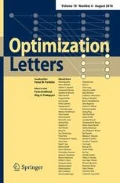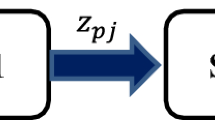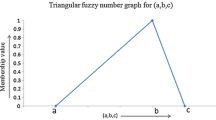Abstract
Data envelopment analysis (DEA) is a useful tool for efficiency measurement of firms and organizations. Many production systems in the real world are composed of two processes connected in series. Measuring the system efficiency without taking the operation of each process into consideration will obtain misleading results. Two-stage DEA models show the performance of individual processes, thus is more informative than the conventional one-stage models for making decisions. When input and output data are fuzzy numbers, the derived efficiencies become fuzzy as well. This paper proposes a method to rank the fuzzy efficiencies when the exact membership functions of the overall efficiencies derived from fuzzy two-stage model are unknown. By incorporating the fuzzy two-stage model with the fuzzy number ranking method, a pair of nonlinear program is formulated to rank the fuzzy overall efficiency scores of DMUs. Solving the pair of nonlinear programs determines the efficiency rankings. An example of the ranking of the 24 non-life assurance companies in Taiwan is illustrated to explain how the proposed method is applied.

Similar content being viewed by others
References
Abbasbandy, S., Hahhari, T.: A new approach for ranking of trapezoidal fuzzy numbers. Comput Math Appl 57, 413–419 (2009)
Bellman, R., Zadeh, L.A.: Decision making in a fuzzy environment. Manag. Sci. 17B, 141–164 (1970)
Charnes, A., Cooper, W.W.: The non-Archimedean CCR ratio for efficiency analysis: a rejoinder to Boyd and Färe. Eur. J. Operat. Res. 15, 333–334 (1984)
Charnes, A., Cooper, W.W., Rhodes, E.: Measuring the efficiency of decision making units. Eur. J. Operat. Res. 2, 429–444 (1978)
Chen, C.B., Klein, C.M.: A simple approach to ranking a group of aggregated utilities. IEEE Trans. Syst. Man Cybern.- Part B 27, 26–35 (1997)
Chen, S.H.: Ranking fuzzy numbers with maximizing set and minimizing set. Fuzzy Sets Syst. 17, 113–129 (1985)
Chen, S.J., Hwang, C.L., Hwang, F.P.: Fuzzy Multiple Attribute Decision Making Method and Applications. Springer, Berlin (1992)
Chen, Y., Cook, W.D., Li, N., Zhu, J.: Additive efficiency decomposition in two-stage DEA. Eur. J. Operat. Res. 196, 1170–1176 (2009)
Cook, W.D., Seiford, L.M.: Data envelopment analysis (DEA)—Thirty years on. Eur. J. Operat. Res. 192, 1–17 (2009)
Chou, S.Y., Dat, L.Q., Yu, V.F.: A revised method for ranking fuzzy numbers using maximizing set and minimizing set. Comp. Ind. Eng. 61, 1342–1348 (2011)
Chu, T.C., Tsao, C.T.: Ranking fuzzy numbers with an area between the centroid point and original point. Comput. Math. Appl. 43, 111–117 (2002)
Facchinetti, G., Ricci, R.G.: A characterization of a general class of ranking functions on triangular fuzzy numbers. Fuzzy Sets Syst. 146, 297–312 (2004)
Guo, P.: Fuzzy data envelopment analysis and its application to location problems. Inform. Sci. 179, 820–829 (2009)
Guo, P., Tanaka, H.: Fuzzy DEA: a perceptual evaluation method. Fuzzy Sets Syst. 119(1), 149–160 (2001)
Gupta, P., Mehlawat, M.K., Verma, S.: COTS selection using fuzzy interactive approach. Optim. Lett. 6, 273–289 (2012)
Hatami-Marbini, A., Emrouznejad, A., Tavana, M.: A taxonomy and review of the fuzzy data envelopment analysis literature: two decades in the making. Eur. J. Operat. Res. 214, 457–472 (2011)
Hatami-Marbini, A., Saati, S., Tavana, M.: Data envelopment analysis with fuzzy parameters: an interactive approach. Int. J. Operat. Res. Inform. Syst. 2, 29–53 (2011)
Jahanshahloo, G.R., Soleimani-Damaneh, M., Nasrabadi, E.: Measure of efficiency in DEA with fuzzy input-output levels: a methodology for assessing, ranking and imposing of weights restrictions. Appl. Math. Comput. 156, 175–187 (2004)
Kao, C.: Interval efficiency measures in data envelopment analysis with imprecise data. Eur. J. Operat. Res. 174, 1087–1099 (2006)
Kao, C., Hwang, S.N.: Efficiency decomposition in two-stage data envelopment analysis: an application to non-life insurance companies in Taiwan. Eur. J. Operat. Res. 185, 418–429 (2008)
Kao, C., Liu, S.T.: Fuzzy efficiency measures in data envelopment analysis. Fuzzy Sets Syst. 113, 427–437 (2000)
Kao, C., Liu, S.T.: A mathematical programming approach to fuzzy efficiency ranking. Int. J. Prod. Econ. 86, 145–154 (2003)
Kao, C., Liu, S.T.: Predicting bank performance with financial forecasts: a case of Taiwan commercial banks. J. Banking Finance 28, 2353–2368 (2004)
Kao, C., Liu, S.T.: Efficiencies of two-stage systems with fuzzy data. Fuzzy Sets Syst. 176, 20–35 (2011)
Korhonen, P.J., Soleimani-damaneh, M., Wallenius, J.: Ratio-based RTS determination in weight-restricted DEA models. Eur. J. Operat. Res. 215, 431–438 (2011)
Leon, T., Liern, V., Ruiz, J.L., Sirvent, I.: A fuzzy mathematical programming approach to the assessment of efficiency with DEA models. Fuzzy Sets Syst. 139, 407–419 (2003)
Liu, S.T.: A fuzzy DEA/AR approach to the selection of flexible manufacturing systems. Comput. Ind. Eng. 54, 66–76 (2008)
Nguyen, H.T.: A note on the extension principle for fuzzy sets. J. Math. Anal. Appl. 64, 369–380 (1978)
Ramón, N., Ruiz, J.L., Sirvent, I.: A multiplier bound approach to assess relative efficiency in DEA without slacks. Eur. J. Operat. Res. 203, 261–269 (2010)
Seiford, L.M., Zhu, J.: Profitability and marketability of the top 55 US commercial banks. Manag. Sci. 45, 1270–1288 (1999)
Soleimani-damaneh, M.: Fuzzy upper bounds and their applications. Chaos Solitons Fractals 36, 217–225 (2008)
Soleimani-damaneh, M.: Establishing the existence of a distance-based upper bound for a fuzzy DEA model using duality. Chaos Solitons Fractals 41, 485–490 (2009)
Soleimani-damaneh, M., Jahanshahloo, G.R., Abbasbandy, S.: Computational and theoretical pitfalls in some current performance measurement techniques and a new approach. Appl. Math. Comput. 181, 1199–1207 (2006)
Thompson, R.G., Singleton, F.D., Thrall, R.M., Smith, B.A.: Comparative site evaluations for locating high energy lab in Texas. Interfaces 16, 1380–1395 (1986)
Thompson, R.G., Langemeier, L.N., Lee, C.T., Thrall, R.M.: The role of multiplier bounds in efficiency analysis with application to Kansas farming. J. Econom. 46, 93–108 (1990)
Wang, W.M., Lee, A.H.I., Chang, D.T.: An integrated FDM-ANP evaluation model for sustainable development of housing community. Optim. Lett. 4, 239–257 (2010)
Zadeh, L.A.: Fuzzy sets as a basis for a theory of possibility. Fuzzy Sets Syst. 1, 3–28 (1978)
Zimmermann, H.Z.: Fuzzy Set Theory Applications, 3rd edn. Kluwer, Boston (1996)
Acknowledgments
This research was supported by National Science Council of the Republic of China under Contract No. NSC100-2410-H-238-006. The author is indebted to the reviewers for their constructive comments that improve the quality of this paper.
Author information
Authors and Affiliations
Corresponding author
Rights and permissions
About this article
Cite this article
Liu, ST. Fuzzy efficiency ranking in fuzzy two-stage data envelopment analysis. Optim Lett 8, 633–652 (2014). https://doi.org/10.1007/s11590-012-0602-5
Received:
Accepted:
Published:
Issue Date:
DOI: https://doi.org/10.1007/s11590-012-0602-5




